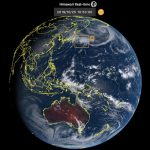 November 25, 2019 2:34 pm
Published by Climate Extremes
November 25, 2019 2:34 pm
Published by Climate Extremes
CLEX researchers investigate the physics of the Antarctic Circumpolar Current to understand why increased wind stress doesn't lead to a more powerful current. It turns out the ocean floor plays a key role.
 November 25, 2019 1:15 pm
Published by Climate Extremes
November 25, 2019 1:15 pm
Published by Climate Extremes
To better understand the biases and ultimately improve the quality of our climate records, CLEX researches and their collaborators undertook in situ measurements using the NOAA Physical Sciences Division flux system during the Clouds, Aerosols, Precipitation, Radiation, and Atmospheric Composition over the Southern Ocean (CAPRICORN) experiment in 2016.
 November 25, 2019 12:46 pm
Published by Climate Extremes
November 25, 2019 12:46 pm
Published by Climate Extremes
This study found in CMIP5 models that are able to simulate both types of events, that convective extremes do not always coincide with warm extremes. The disassociation becomes more distinct under greenhouse warming with higher occurrences of convective extremes than warm extremes.
 November 25, 2019 12:15 pm
Published by Climate Extremes
November 25, 2019 12:15 pm
Published by Climate Extremes
This paper investigates the annual cycle in cloud and rainfall measurements over the western equatorial Indian Ocean. While there is a single period of strong rainfall over the region during December-January each year, there are two periods of increased high-top clouds associated with convection.
 November 6, 2019 11:20 am
Published by Climate Extremes
November 6, 2019 11:20 am
Published by Climate Extremes
CLEX researchers and colleagues found the Aridity Index was too simplistic to capture the many aspects that define landscape aridity, including the amount of rainfall, water resources and vegetation productivity, and is a poor indicator of future aridity changes.
 October 25, 2019 12:23 pm
Published by Climate Extremes
October 25, 2019 12:23 pm
Published by Climate Extremes
With projected increases in temperature in the future, the amount of water vapour that can be held at saturation – before it condenses into clouds, dew or water film – increases exponentially. As this deficit increases plants tend to close their stomata, which reduces water fluxes into the boundary layer. Do models currently capture the observed leaf-level response to increasing vapour pressure deficit? What about at very high levels of this deficit?
 October 25, 2019 11:31 am
Published by Climate Extremes
October 25, 2019 11:31 am
Published by Climate Extremes
While the data from Himiwari-8 provides very useful data on clouds at relatively high resolution, researchers need to know if it produced any biases, particularly around cloud-top height and cloud-top temperature, whose roles are critical in shaping Earth’s climate. CLEX researchers and Australian colleagues compared the Himawari-8 data for both of these measures with existing datasets.
 October 22, 2019 2:26 pm
Published by Climate Extremes
October 22, 2019 2:26 pm
Published by Climate Extremes
The energy of vortices in the Southern Ocean has increased over the past two decades due to an increase in the mean amplitude of the vortices rather than an increase in their number.
 October 22, 2019 1:42 pm
Published by Climate Extremes
October 22, 2019 1:42 pm
Published by Climate Extremes
A known weakness of the Ensemble Kalman filter approach is that its ability to provide state estimates that closely match densely distributed observations is very limited. This paper describes a computationally inexpensive innovative variation on the technique that greatly ameliorates this difficulty.
 October 22, 2019 1:26 pm
Published by Climate Extremes
October 22, 2019 1:26 pm
Published by Climate Extremes
A new study with Centre of Excellence researchers warns that changes in springtime winds high above the South Pole could trigger higher than usual heat waves and fire-prone weather conditions in Australia.










